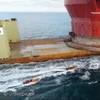Working out of San Diego's Fisherman's Landing Marina, J.J. Gerritsen recently repowered his 65 by 22-ft. aluminum charter fishing boat, Apollo. For Gerritsen, sport fishing is a serious business dependent on the unpredictability of fish and weather. Given those two great unknowns, he has learned you can't leave anything else to chance. In the heavily populated southern California market, Gerritsen is also aware of the crucial relation between a healthy environment and success in the hospitality industry.
"We were running a pair of the smoke-belching, old, two-cycle engines," he says, "They were the standard in our industry. We understood them and had reliable mechanics and spares available. We can't afford any downtime in our business. So when we looked at repowering with a pair of Cummins QSM11 we were skeptical about reliability and parts availability. It was such a concern that Cummins set up a 24-hour emergency number for us, and we have now found them to be prompt and reliable."
An important aspect of the decision to repower was California's Carl Moyer program. The program is supported by an appropriation of $50 million dollars for the 2000-2001 fiscal year. A significant portion of this amount was allotted for Carl Moyer Program incentive grants, as a means to reduce emissions from heavy-duty engines.
These grants cover the incremental cost of cleaner on-road, off-road, marine, locomotive and stationary agricultural pump engines, as well as forklifts and airport ground support equipment. Beginning in summer 1999, grants became available through participating air pollution control and air quality management districts grants.
"Heavy-duty engines are a significant source of smog-forming pollutants," says a State of California press release, adding that, " In addition, the fine particulate matter exhaust from heavy-duty diesel engines is a toxic air contaminant. The incentive program focuses on reducing emissions of smog-forming oxides of nitrogen (NOx), but will also reduce particulate emissions. In recognition of his work in the air quality field and his efforts in bringing about this program, the incentive program is named after the late Dr. Carl Moyer."
With assistance from the Ventura County Air Pollution Control District and the Carl Moyer Fund, Gerritsen chose a pair of Cummins fully electronic 580 hp QSM11s supplied by Seaboard Marine and Cummins Cal Pacific. The engines have met all of Gerristsen's needs not only with lowered NOx emissions, but also virtually elimination particulate. "They never smoke," he says, pointing out the value of this in a boat that carries up to 30 people who spend much of their time on deck fishing. Like many boats in the Southern California charter fleet, the "Apollo" fishes inshore rock fish on day trips as well as longer tuna trips that can take her well off shore. For this work she is equipped with extensive electronics, including a Westmar side scan sonar, Furuno GPS, Furuno color sounder, sat-nav/chart plotter, three VHF radios with direction finders, a tunable SSB radio and a geography graph plotter. When traveling to the grounds they typically run the engines at an easy and fuel efficient 1,600 rpm for 10 to 11 knot speeds. For trolling the engines are slowed to around 1,000 rpm, "But they never have wet cylinders or smoke," explains Gerritsen.
The Sportfishing Association of California, to which Gerritsen belongs, includes among its members, over 175 open-party and charter boats ranging in length from 45 to 120 ft. and running from 23 different landings from Morro Bay to San Diego. They carry between 700,000 and one million passengers a year to local coastal banks and islands, and into Mexican waters. Much of the $80 million monetary investment in this fleet is in the boat's main engines. Association president Bob Fletcher says, "The regulator environment in California is such that repowering for most of our fleet is inevitable. So when the Carl Moyer program was introduced it became a life line to these small businesses, most of which are owner-operators, earning relatively small returns on their investment. A number of our members have repowered to gain lower emissions with the added benefit of lower fuel consumption, improved speed and power to weight ratios. The program has been a real bonus for us."
Sponsored Content
Innovative Hull Maintenance: Profitable & Green

Subscribe for
Maritime Reporter E-News
Maritime Reporter E-News is the maritime industry's largest circulation and most authoritative ENews Service, delivered to your Email five times per week













